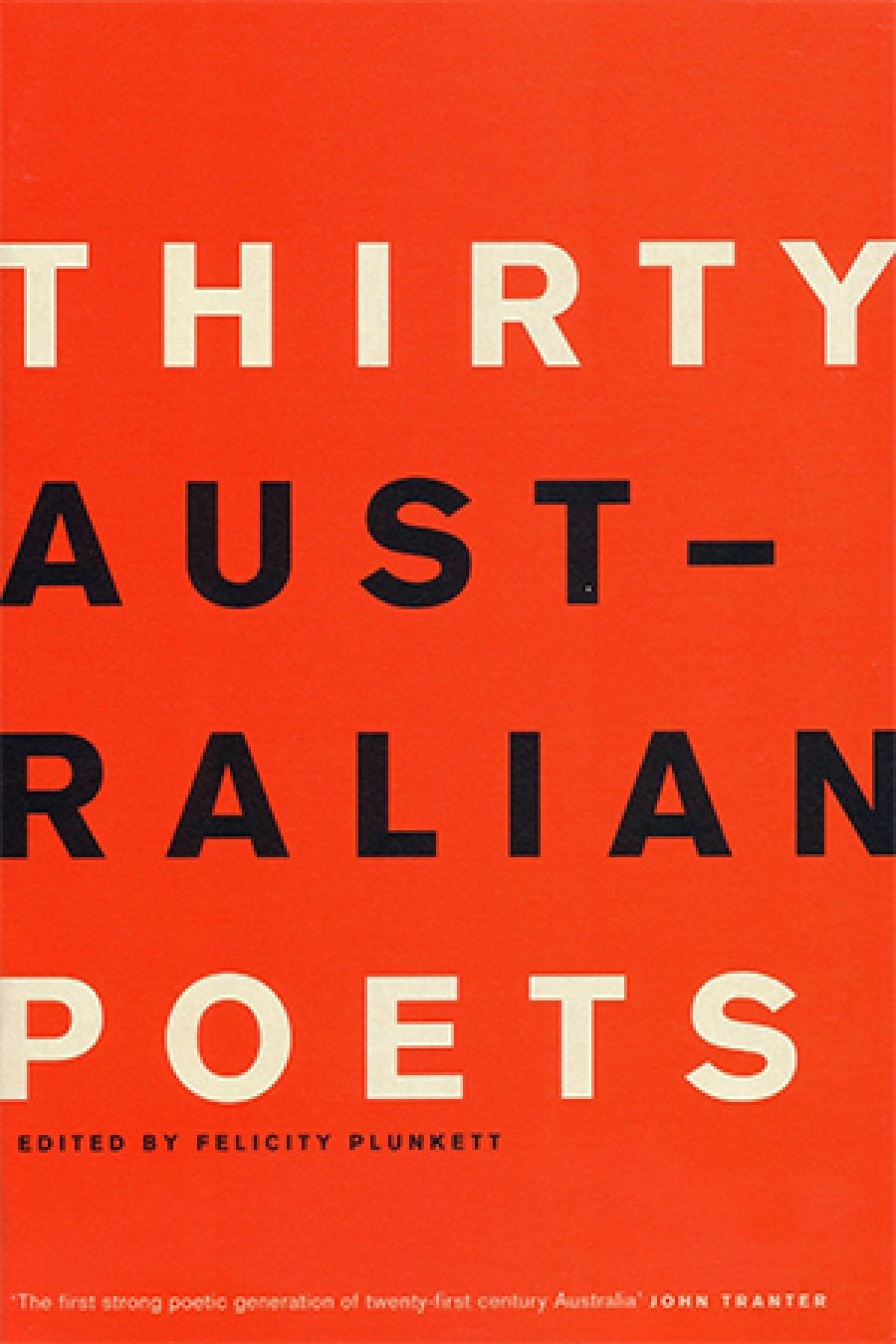
- Free Article: No
- Contents Category: Poetry
- Review Article: Yes
- Online Only: No
- Custom Highlight Text:
Although it has been almost half a century since 1968, a year readily mythologised in Australian poetry, the so-called Generation of ’68 are still the most talked-about contemporary poets. There have been few attempts to define the next generations of poets. Forty-three years is a long definition of what might be deemed ‘contemporary’.
- Book 1 Title: Thirty Australian Poets
- Book 1 Biblio: University of Queensland Press, $27.95 pb, 304 pp, 9780702239144
It makes sense, then, that Felicity Plunkett’s anthology takes its bearings from the Generation of ’68. Each of the poets featured in Thirty Australian Poets was born after that landmark year. The move is both cheeky and respectful, and opens the anthology to a wide diversity of writers. Plunkett eschews troubling categories of ‘young’, ‘new’, or ‘emerging’, and focuses instead on what is current.
This diversity is the real strength of the book. Plunkett is aware of the problems of selection, representation, and canonisation inherent in anthologising poetry, and of how political anthologisation can be. This awareness is particularly timely, given widespread criticism of the nationalist and anti-experimentalist agenda of the Lehmann–Gray anthology, Australian Poetry Since 1788 (reviewed elsewhere in this issue).With this in mind, the poems have been chosen to represent a wide range of poets and poetries operating in Australia today – from the delicate lyricism of Jane Gibian, to the manic energy of Justin Clemens, the jagged rhythms of Samuel Wagan Watson, and Kate Fagan’s remixes and centos. This variety of poetic approaches is especially pleasing given the divisive argument and sometimes petty point-scoring that has been evident in recent discussions of contemporary Australian poetry, especially in online forums.
This is not to say that the anthology is apolitical or appeasing. Indeed, there are statements of poetic creed and practice in many of the pieces. Poets such as Maria Takolander and Esther Ottoway offer poems that are direct and almost excoriating in their depiction of female experience, whereas David Prater’s ‘A821.4’ (the Dewey classification code for Australian Literature) satirises the entire industry of writing itself, in a country that is largely indifferent to its poets. More importantly, poems such as John Mateer’s ‘One Year’ and Joel Deane’s ‘Guantánamo’ are directly engaged with the politics of writing and witness, terror and war, and prove that politics is by no means as absent from Australian poetry as is often claimed.
Diversity is political in itself in Thirty Australian Poets. The vision of Australia it offers is much more international – more ‘worldly’, as David McCooey puts it in the anthology’s foreword – than that of many other recent anthologies, and one that stands in direct opposition to simple nationalism. The poems have the entire world as their stage, with foreign landscapes, foreign languages, travellers and wanderers and migrants every bit as important as more local landscapes and themes within the book.
What this means is that poems as startlingly estranged and international as Michael Brennan’s ‘Letter Home’ – ‘These are strange lands I barely understand. / We are walking in a park of manicured lawns […] The people here douse themselves in petrol / As though poetry mattered’ – can exist in close proximity to John Mateer’s ‘Ode’ – ‘Kangaroo paw, / scarlet dipstick measuring / the depth of blood in which we live’.
Furthermore, of the thirty poets in the collection, seven have migrant backgrounds, while nine currently live overseas. Others have studied or undertaken residencies across the globe. While this travel is not unique among Australian poets, it is refreshing to see their different perspectives fostering an idea of Australianness that seems less self-conscious, less anxious than what has come before.
As well as highlighting contemporary poets’ mobility and cosmopolitanism, Thirty Australian Poets also brings into focus the different poetic traditions that inform their work. Many poems pay tribute – whether playfully or reverently – to important poets of the past. In Joel Deane’s magnificent ‘Man to Woman’, which reworks Judith Wright’s famous ‘Woman to Man’, the poem’s emotional impact is all the more devastating because this engagement with tradition lends it a sense of enduring time and experience. Elsewhere, there is audacity and imagination, with poems such as Louis Armand’s ‘Patrick White as a Headland’ and Jaya Savige’s ‘Dransfield in Bavaria’ playing fast and loose with venerated figures from the past, many of whom, fittingly enough, are ’68ers themselves.
Once again, this engagement is not just with Australian poets or with Australian poetry as the only important context in which these new poets work. International writers and traditions abound; Ali Alizadeh nods to Rumi, Emma Jones to Rilke, Danijela Kambaskovic-Sawers to Homer, in her hilarious ‘The Williad: The Writer and the Monsters of Child and Housework’:
…the Growing Pile of Dishes
stabbed her in the eye, and the Toilet
Bowl
let out a murky howl. Its voice was
drowned
by the cacophony of Dirty Sheets
begging for a change…
Similarly, there is an intense awareness of legacy and lineage in the work of many of the female poets, often a deliberate attempt to redefine a place for the history of female creativity behind them. Claire Potter’s ‘Ladies of the Canon’, a particularly interesting poem, plays with ideas of femininity, artistry, and muses, but also with a title so pointedly suggestive of recent debates about lyricism and experimentalism within contemporary poetry. Again, the real strength of Thirty Australian Poets isthat it holds itself outside these debates, and allows a plurality of traditions to interact.


Comments powered by CComment